Related Research Articles
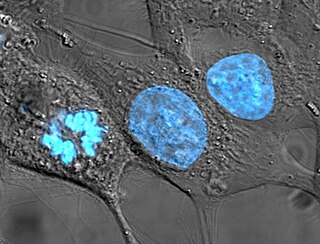
The cell nucleus is a membrane-bound organelle found in eukaryotic cells. Eukaryotic cells usually have a single nucleus, but a few cell types, such as mammalian red blood cells, have no nuclei, and a few others including osteoclasts have many. The main structures making up the nucleus are the nuclear envelope, a double membrane that encloses the entire organelle and isolates its contents from the cellular cytoplasm; and the nuclear matrix, a network within the nucleus that adds mechanical support.

Arabidopsis thaliana, the thale cress, mouse-ear cress or arabidopsis, is a small plant from the mustard family (Brassicaceae), native to Eurasia and Africa. Commonly found along the shoulders of roads and in disturbed land, it is generally considered a weed.

The cytoskeleton is a complex, dynamic network of interlinking protein filaments present in the cytoplasm of all cells, including those of bacteria and archaea. In eukaryotes, it extends from the cell nucleus to the cell membrane and is composed of similar proteins in the various organisms. It is composed of three main components: microfilaments, intermediate filaments, and microtubules, and these are all capable of rapid growth or disassembly depending on the cell's requirements.

The nucleoplasm, also known as karyoplasm, is the type of protoplasm that makes up the cell nucleus, the most prominent organelle of the eukaryotic cell. It is enclosed by the nuclear envelope, also known as the nuclear membrane. The nucleoplasm resembles the cytoplasm of a eukaryotic cell in that it is a gel-like substance found within a membrane, although the nucleoplasm only fills out the space in the nucleus and has its own unique functions. The nucleoplasm suspends structures within the nucleus that are not membrane-bound and is responsible for maintaining the shape of the nucleus. The structures suspended in the nucleoplasm include chromosomes, various proteins, nuclear bodies, the nucleolus, nucleoporins, nucleotides, and nuclear speckles.

Lamins, also known as nuclear lamins are fibrous proteins in type V intermediate filaments, providing structural function and transcriptional regulation in the cell nucleus. Nuclear lamins interact with inner nuclear membrane proteins to form the nuclear lamina on the interior of the nuclear envelope. Lamins have elastic and mechanosensitive properties, and can alter gene regulation in a feedback response to mechanical cues. Lamins are present in all animals but are not found in microorganisms, plants or fungi. Lamin proteins are involved in the disassembling and reforming of the nuclear envelope during mitosis, the positioning of nuclear pores, and programmed cell death. Mutations in lamin genes can result in several genetic laminopathies, which may be life-threatening.

The nuclear lamina is a dense fibrillar network inside the nucleus of eukaryote cells. It is composed of intermediate filaments and membrane associated proteins. Besides providing mechanical support, the nuclear lamina regulates important cellular events such as DNA replication and cell division. Additionally, it participates in chromatin organization and it anchors the nuclear pore complexes embedded in the nuclear envelope.

The transfer DNA is the transferred DNA of the tumor-inducing (Ti) plasmid of some species of bacteria such as Agrobacterium tumefaciens and Agrobacterium rhizogenes . The T-DNA is transferred from bacterium into the host plant's nuclear DNA genome. The capability of this specialized tumor-inducing (Ti) plasmid is attributed to two essential regions required for DNA transfer to the host cell. The T-DNA is bordered by 25-base-pair repeats on each end. Transfer is initiated at the right border and terminated at the left border and requires the vir genes of the Ti plasmid.
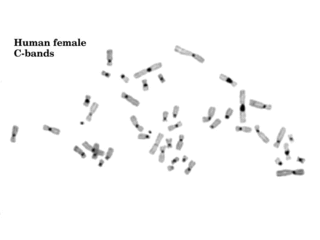
Constitutive heterochromatin domains are regions of DNA found throughout the chromosomes of eukaryotes. The majority of constitutive heterochromatin is found at the pericentromeric regions of chromosomes, but is also found at the telomeres and throughout the chromosomes. In humans there is significantly more constitutive heterochromatin found on chromosomes 1, 9, 16, 19 and Y. Constitutive heterochromatin is composed mainly of high copy number tandem repeats known as satellite repeats, minisatellite and microsatellite repeats, and transposon repeats. In humans these regions account for about 200Mb or 6.5% of the total human genome, but their repeat composition makes them difficult to sequence, so only small regions have been sequenced.
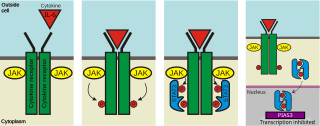
Protein inhibitor of activated STAT (PIAS), also known as E3 SUMO-protein ligase PIAS, is a protein that regulates transcription in mammals. PIAS proteins act as transcriptional co-regulators with at least 60 different proteins in order to either activate or repress transcription. The transcription factors STAT, NF-κB, p73, and p53 are among the many proteins that PIAS interacts with.

The nuclear envelope, also known as the nuclear membrane, is made up of two lipid bilayer membranes that in eukaryotic cells surround the nucleus, which encloses the genetic material.

Heterogeneous nuclear ribonucleoprotein U is a protein that in humans is encoded by the HNRNPU gene.

Scaffold attachment factor B, also known as SAFB, is a gene with homologs that have been studied in humans and mice.

Lamin-B1 is a protein that in humans is encoded by the LMNB1 gene.

Inner nuclear membrane proteins are membrane proteins that are embedded in or associated with the inner membrane of the nuclear envelope. There are about 60 INM proteins, most of which are poorly characterized with respect to structure and function. Among the few well-characterized INM proteins are lamin B receptor (LBR), lamina-associated polypeptide 1 (LAP1), lamina-associated polypeptide-2 (LAP2), emerin and MAN1.
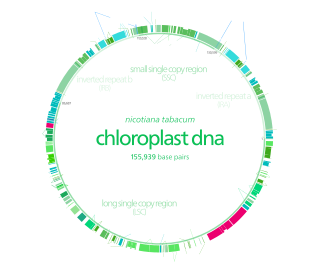
Chloroplast DNA (cpDNA) is the DNA located in chloroplasts, which are photosynthetic organelles located within the cells of some eukaryotic organisms. Chloroplasts, like other types of plastid, contain a genome separate from that in the cell nucleus. The existence of chloroplast DNA was identified biochemically in 1959, and confirmed by electron microscopy in 1962. The discoveries that the chloroplast contains ribosomes and performs protein synthesis revealed that the chloroplast is genetically semi-autonomous. The first complete chloroplast genome sequences were published in 1986, Nicotiana tabacum (tobacco) by Sugiura and colleagues and Marchantia polymorpha (liverwort) by Ozeki et al. Since then, a great number of chloroplast DNAs from various species have been sequenced.
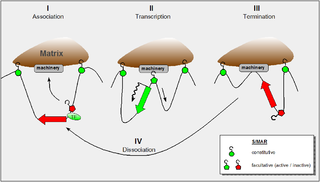
The term S/MAR, otherwise called SAR, or MAR, are sequences in the DNA of eukaryotic chromosomes where the nuclear matrix attaches. As architectural DNA components that organize the genome of eukaryotes into functional units within the cell nucleus, S/MARs mediate structural organization of the chromatin within the nucleus. These elements constitute anchor points of the DNA for the chromatin scaffold and serve to organize the chromatin into structural domains. Studies on individual genes led to the conclusion that the dynamic and complex organization of the chromatin mediated by S/MAR elements plays an important role in the regulation of gene expression.
In molecular biology, the protein domain, YTH refers to a member of the YTH family that has been shown to selectively remove transcripts of meiosis-specific genes expressed in mitotic cells.

Nuclear organization refers to the spatial distribution of chromatin within a cell nucleus. There are many different levels and scales of nuclear organisation. Chromatin is a higher order structure of DNA.
Decreased DNA Methylation I (DDM1), is a plant gene that encodes a nucleosome remodeler which facilitates DNA methylation. The DDM1 gene has been described extensively in Arabidopsis thaliana and also in maize. The protein has been described to be similar to the SWI2/SNF2 chromatin remodeling proteins.
Plant nucleus movement is the movement of the cell nucleus in plants by the cytoskeleton.
References
- ↑ Berezney, Ronald; Coffey, Donald S. (October 1974). "Identification of a nuclear protein matrix". Biochemical and Biophysical Research Communications. 60 (4): 1410–1417. doi:10.1016/0006-291X(74)90355-6. PMID 4214419.
- ↑ Pederson T (March 2000). "Half a century of "the nuclear matrix"". Molecular Biology of the Cell. 11 (3): 799–805. doi:10.1091/mbc.11.3.799. PMC 14811 . PMID 10712500.
- ↑ ZBARSKII, I.B; DEBOV, S.S. (1948). "On the proteins of the cell nucleus". Dokl Akad Nauk SSSR. 63: 795–798.
- ↑ Tetko IV, Haberer G, Rudd S, Meyers B, Mewes HW, Mayer KF (March 2006). "Spatiotemporal expression control correlates with intragenic scaffold matrix attachment regions (S/MARs) in Arabidopsis thaliana". PLOS Computational Biology. 2 (3): e21. Bibcode:2006PLSCB...2...21T. doi: 10.1371/journal.pcbi.0020021 . PMC 1420657 . PMID 16604187.
- ↑ Hancock, Ronald (2000-07-05). "A new look at the nuclear matrix". Chromosoma. 109 (4): 219–225. doi:10.1007/s004120000077. ISSN 0009-5915. PMID 10968250. S2CID 8471350.
- ↑ Razin, S. V.; Borunova, V. V.; Iarovaia, O. V.; Vassetzky, Y. S. (July 2014). "Nuclear matrix and structural and functional compartmentalization of the eucaryotic cell nucleus". Biochemistry (Moscow). 79 (7): 608–618. doi: 10.1134/S0006297914070037 . ISSN 0006-2979. PMID 25108324. S2CID 1678398.
- ↑ Hancock, Ronald (2000-07-05). "A new look at the nuclear matrix". Chromosoma. 109 (4): 219–225. doi:10.1007/s004120000077. ISSN 0009-5915. PMID 10968250. S2CID 8471350.
- ↑ Kallappagoudar S, Varma P, Pathak RU, Senthilkumar R, Mishra RK (September 2010). "Nuclear matrix proteome analysis of Drosophila melanogaster". Molecular & Cellular Proteomics. 9 (9): 2005–18. doi: 10.1074/mcp.M110.001362 . PMC 2938118 . PMID 20530634.
- ↑ Bozza M, De Roia A, Correia MP, Berger A, Tuch A, Schmidt A, et al. (April 2021). "A nonviral, nonintegrating DNA nanovector platform for the safe, rapid, and persistent manufacture of recombinant T cells". Science Advances. 7 (16): eabf1333. Bibcode:2021SciA....7.1333B. doi:10.1126/sciadv.abf1333. PMC 8046366 . PMID 33853779.
- ↑ Rynearson AL, Sussman CR (June 2011). "Nuclear structure, organization, and oncogenesis". Journal of Gastrointestinal Cancer. 42 (2): 112–7. doi:10.1007/s12029-011-9253-5. PMID 21286858. S2CID 45830528.